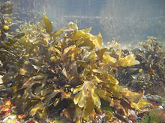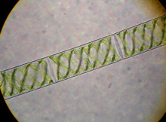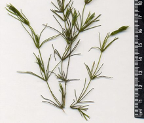Algae Growth with LED Lighting
Algae is defined as a large and diverse group of photosynthetic eukaryotic organisms typically found in damp places or in water. Most algae are autotrophic in that they make organic compounds from simple molecules by taking in energy from the environment such as the sun. Algae play significant roles in aquatic ecology. Microscopic forms that live suspended in water are called phytoplankton, and provide the food base for most marine food chains. The most complex marine algae are seaweeds, while the most complex freshwater forms are Charophyta, a division of green algae which includes spirogyra and stoneworts.

Seaweed 
Spirogyra 
Stoneworts
Farming of algae, also known as algaculture, is on the rise globally. Algae contain high levels of oils, carbohydrates, sugars, and proteins, and can be used to produce renewable fuel, medical drugs, foods, and cosmetics. Algae are already widely used in food products, from baby formula to ice-cream, providing texture, stabilizing features, and important nutrients for health. Growing concerns regarding the emission of greenhouse gases have driven investment into algae production as a potential alternative fuel. In addition, the plastics industry has upped its demand for algae to produce biodegradable plastics. According to Allied Markets Research, the global algae products market is expected to generate $3.5 billion by 2025 with growth driven primarily by increased demand for protein-based nutritional additives for healthy foods.
Similar to the challenges facing greenhouse food and flower growers that are reliant on the sun, artificial lighting is utilized in algaculture as a supplement to control harvest cycle time and product consistency. Historically, lighting technologies used in algae production were high pressure sodium, metal halide, and fluorescents. Drawbacks of these legacy technologies are the inability to control spectrum and intensity, energy inefficiency, and hazardous chemicals could contaminate the algae. Recent developments in LED technology have made them the preferred lighting solution in many commercial operations. LEDs offer light output spectrum that can be optimized for penetration through water and photosynthesis, as well as being safer (no harmful chemicals) and more energy efficient. While the “best” spectrum of light is somewhat dependent on the specific algae being targeted, there are general principles that hold true. Like land-based plants, algae strongly absorb and process chlorophyll a & b (red & blue light).

Absorption spectra of a few algae are shown in the graph. Algae are typically submerged, so the light will need to traverse through some length of water before reaching its target. From the graph, red light is quickly absorbed by water. Blue light is more readily absorbed if the water contains an average amount of organic material. Through a long path of water, green light has the highest transmission

Taking into consideration algae absorption and water transmission, many algaculture farmers choose a full white light spectrum. Other considerations in choosing a light include water/dust resistance, commonly referred to as ingress protection (IP rating). If the lights are to be completely submerged or operated outdoors, they should have an IP68 rating (dust tight and waterproof). Frequently, a separate enclosure is constructed in which the lights are placed since there is a very limited selection of IP68 rated lights.
Thrive Agritech has delivered its LED lighting products to leading microalgae producer, NFusion Technologies, headquartered in Phoenix, Arizona. NFusion purchased the lights due to their optimized full white light photosynthetic spectrum, ease of installation and IP66 rating. Thrive’s lights grow algae to be used as organic soil fertilizer for healthier and more sustainable modern farming.